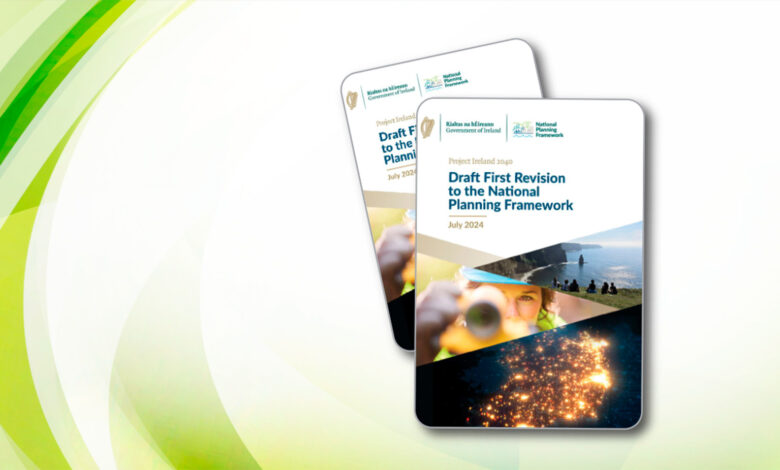Much anticipated draft National Planning Framework Revision published

Government has published the Draft First Revision to the National Planning Framework (NPF) – the planning framework for socioeconomic and cultural development of the State out to 2040 – which anticipates the need for ~50,000 additional homes each year.
Provided with government approval to commence 20 June 2023, the Draft First Revision to the National Planning Framework was published for public consultation on 10 July 2024 and intends to update the NPF to reflect changes in government policy, not least in climate action, regional development, demography, and digitalisation.
The consultation will run until 12 September 2024, a deadline which Sinn Féin housing spokesperson Eoin Ó Broin TD suggested “is far too tight” given that “it leaves a very short period and people will be on holidays”.
“I do not think we will get the political oversight of this over the summer months,” added Green Party TD and spokesperson for transport, climate action and environment, Brian Leddin.
Speaking to eolas Magazine in summer 2024, Minister for Housing, Local Government and Heritage Darragh O’Brien TD indicated that he wanted to see the revised NPF “implemented in September [2024]”.
“While some of the commentariat and opposition are talking about targets on housing, we are getting on with building the houses. We exceeded the [overall] target in 2023, we exceeded it the year before, and we intend to exceed it this year.

“It [the first revision] does not stop the work that we are doing, but it is important that we reset based on the increasing population and with population trends. The NPF will underpin that. More than likely, we will be asking local authorities to revisit their development plans to zone more appropriate lands for additional housing delivery,” he insisted.
Following the consideration of the submissions received and government approval, the final draft will require approval by the Houses of the Oireachtas before being published. When this process is concluded, the revised NPF will be incorporated into regional spatial and economic strategies and the city and county development plans, including via the finalised updates to housing supply targets.
The original NPF was published in February 2018 as one of two main components of Ireland 2040 – alongside the National Development Plan – and replaced the National Spatial Strategy.
In March 2023, Housing Minister Darragh O’Brien TD commission an expert group to undertake a high-level review and determine the scope of the first revision. The expert group’s report was submitted to the Minister in August 2023 and published that September.
Appearing before the Joint Oireachtas Committee on Housing, Local Government and Heritage on 11 July 2024, acting Assistant Secretary of the Planning Division within the Department of Housing, Local Government and Heritage, Paul Hogan, updated members on the 190-page draft revision.
“It is an important document. It is at the apex of the planning hierarchy,” Hogan told the committee, adding: “It is a high-level framework. It is a direction of travel. It has been mischaracterised as a blueprint, which it is not. That cascades down through the planning system.”
The NPF is underpinned by the Planning and Development Act 2000 (as amended) and the Planning and Development Bill, 2023.
Also published in July 2024 was the ESRI’s Population Projections, The Flow of New Households and Structural Housing Demand which estimates structural (demographic or emerging) housing demand of approximately 44,000 homes per annum (based on an average of 12 scenarios) from 2023 to 2030 and 39,700 from each year from 2030 to 2040. Though the report also acknowledges that structural demand projections are very exposed to international migration, household size, and housing obsolescence.

Taken together with the May 2024 Report of The Housing Commission – which estimates that, as of Census 2022, the State’s housing supply deficit was between 212,500 and 256,000 homes. This equates to unmet housing demand of between 15,000 and 25,000 new homes each year from 2025-2034.
Assuming a rounded mid-range figure of 235,000 for the overall deficit between 2025 and 2034, an average annual figure of 23,500 new homes would have to be delivered to address pent-up demand alone.
Adding this mid-range figure to Housing for All’s current target of an average delivery of 33,000 homes between 2022 and 2030, this would equate to an average annual delivery of 56,500 new homes between 2025 and 2034.
However, using the ESRI’s structural demand projection alongside the Commission’s deficit range results in a total annual housing demand of between 60,000 and 70,000 new homes. In fact, on a nine-year trajectory to 2034, The Housing Commission recommends the delivery of 70,000 homes in years 2029 and 2030.
However, DHLGH suggests that having consideration of the ESRI’s projections, allied to the Department’s “preliminary analysis on previously unmet demand”, the October 2024 update to Housing for All’s annual housing targets will arrive at 50,000 new homes on average per annum. Though the Department clarifies that the exact figure will be published in October and the new targets will be effective from 2025.
In this context, Sinn Féin’s Ó Broin was decidedly unimpressed by the draft revision’s conclusion that an average of 50,000 new homes will need to be delivered to 2040, suggesting that it underestimates housing need.
Responding to a question from Ó Broin during his appearance before the Oireachtas housing committee, DHLGH’s Hogan asserted: “Clearly, there will be further detailed analysis of a more precise figure for the autumn Housing for All revised action plan document and that will probably be of the order of slightly more than 50,000 for the period to 2030.”
Reiterating that the First Revision to the NPF “is not a housing plan” but rather “a strategic, long-term planning document for the next 16 years”, he suggests that while the revision concludes that an average of 50,000 must be delivered each year until 2040, “how that will stack up against the next few years, the pent-up demand and so on has yet to be worked out in fine detail.”

The 50,000 figure, he says, was determined by taking the ESRI’s structural demand figures and “making reasonable allowances based on the previous methodology for unmet demand” before averaging the figure over 16 years to 2040. However, he makes clear that “we [DHLGH] are not offering a definitive position on that right now” and that 50,000 is “a reasonable working assumption”.
It is also a figure that aligns with Taoiseach Simon Harris TD’s assertion that a Fine Gael government would deliver 250,000 homes over the next five years.
However, Ó Broin insisted that he did not believe that this figure is reasonable given that The Housing Commission has recommended the delivery of a minimum annual average of 60,000 new homes. The figure contained in First Revision to the NPF would, he argues, amount to an under delivery of 100,000 homes in a decade.
In a subsequent statement, Ó Broin observed: “The draft [revision] says that there is a need for 50,000 new homes a year from now to 2040. When Department of Housing officials were asked to explain how this number had been arrived at, they were not able to provide a clear answer… The Department of Housing’s figure of 50,000 new homes a year makes no sense.”
Regional balance
While DHLGH maintains that the draft revision “retains the original NPF focus on a more balanced distribution of growth across all of Ireland’s regions”, this is disputed by the opposition.
Referencing Census 2022, the draft revision suggests that “emerging changes in population distribution… are encouraging” and identifies a pattern of growth across all three regions.
Acknowledging that there is a greater rate of population growth in Dublin and the mid-east and that “the transition to balanced regional development is taking time to materialise”, the draft revision places emphasis on ensuring equitable growth between and east and midlands and the rest of the State.

Discussing the draft revision, Minister of State with special responsibility for Planning and Local Government, Alan Dillon TD observed: “As our population continues to grow, 50:50 regional balance between our major cities and rural regional towns is essential to ensuring rural Ireland prospers at the same rate as our cities.”
Meanwhile, when asked by Deputy Leddin to define “balanced regional development”, senior advisor with DHLGH’s National, Regional and Urban Policy Unit, Alma Walsh emphasised that the principle is provided for within the Planning and Development Act 2000.
“Retaining this approach to balanced regional development in this revised version is about addressing the imbalance in how and, in particular, where development has been taking place, with a concentration in Dublin and the mid-east area. The balanced regional development piece is to address that concentration to ensure that other parts of the country… also grow to their potential and offer an alternative and rebalance of the distribution of growth,” says Walsh.
However, Leddin is unconvinced, accusing DHLGH of “doubling down” on “the failure of the NPF”, insisting: “There is no rebalance here. If anything, there is a move away from balance from the original 2018 document… What we are seeing now is not a strategic document or vision – this should be a vision for the shape of the country in ten, 20- or 30-years’ time – but a reaction to where we see demand happening.”
This is disputed by Hogan who observed: “That is simply not the case. The reality is there was much discussion and consideration of balanced regional development and what that meant in 2017 and 2018 when we were devising the strategy in the first place. We set a course, and this is a revision of that strategy. We are not abandoning the strategy; we are updating it.”
Reaction
Upon publishing the draft revision, the Housing Minister asserted: “The world has changed significantly since the NPF was first published in 2018, and we must ensure our national planning strategy is appropriate for our current and future needs. These changes need to be reflected in the NPF as they impact on how we plan for the country’s growth and development, particularly in relation to our growing and changing population and our climate action commitments… Crucially, a revised framework will guide our continued momentum in housebuilding.”
Speaking with eolas Magazine in summer 2024, Ó Broin addressed the context in which he will publish his party’s alternative housing plan. At that time, he suggested that he was not hinging his plan on about the National Planning Framework revision “because in some senses, The Housing Commission’s report has moved ahead of that”.
Overall, the impact of the draft revision on the update to Housing for All will become apparent in October 2024.





